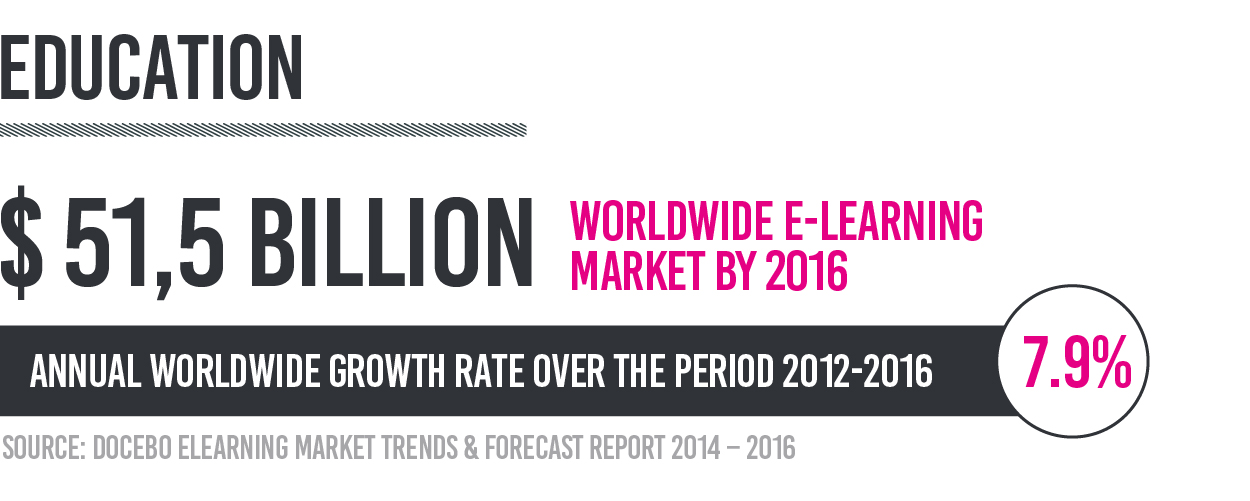![]() 5 minute read
5 minute read
Oxford dictionary interprets gamification as “the application of typical elements of game playing (e.g. point scoring, competition with others, rules of play) to other areas of activity, typically as an online marketing technique to encourage engagement with a product or service.” Indeed, utilizing the human behavioral factors, one can stimulate others to enhance the performance with peer pressure, leaderboard competition and other types of gaming motivation. This article examines the possibilities and implementation of gamification in the work environment, marketing and education.
What’s at stake
Essentially, gamification is a human-focused design solution. That is to say, with the digital development the world shifts from being technology oriented towards human performance enhancement. Thus, the gamification market will grow with the world digitalisation. The market is expected to be as large as $5,5 billion in 2018 with 67 percent annualized growth from 2013 to 2018. In fact, the gamification is entering into all activities and sectors with human interaction.

Even though the main mechanisms of gamification are points, badges, leaderboards, challenges, and levels – that is not what makes the game fun. The actual meaning for most of the gamers is triggering their creativity, find new solutions, and acquiring new skills, while enjoying interactive or board games. The gamers of nowadays are not only teenagers or single man as it comes with stereotypes. The members of the gaming community are middle-aged persons, and half of them are female.
Employees
on fire
Besides making the workplace digital, the new behavioral solutions to boost productivity via gamification take place. Gamification is recognized as a data-driven motivation strategy that has a potential to improve both employers’ and clients’ engagement levels. No need to punish employees for playing on the workplace. Vice versa, today workers are encouraged for gaming collaboration. GALLUP reports that only 13 percent of the employees worldwide are engaged at the[nbsp]workplace. According to MediaPost, 90 percent of Millennials want their workplace to be more social and fun. Therefore, it does not come as a surprise, that gamification a solution to engage employees.

An introduction of collaboration platform to the working space worked well for T-Mobile in 2013. The company reported that employers’ participation in corporate gamification increased contributions by 583 percent, while responses jumped up to 783 percent. It also led to customer satisfaction scores improvement by 31 percent and call deflection improvement by 40 percent. All in all, the results of implementing gamification to collaboration platform reduced costs, improved client service quality, and engaged employees in the company. Other companies to utilize gamification, like Coca-Cola, RMH Franchise Corporation, and others, have also reported the positive correlation with the employees performance and productivity and the behavioral motivation. The workplace has a potential to become the place of joy and fun with high productivity scores.
Marketing with
the game
The marketing has evolved to online, and the engagement of visitors is one of the main drivers of the sales growth. The attraction of potential clients and growth of the loyalty rates is one of the challenges of today’s overcrowded market. Gamification has proven to trigger the long-term relationships between brand and client. Moreover, the marketing gaming design can evolve into a viral campaign.

Coca-Cola was awarded “The Best Use of Gamification 2014” for its marketing campaign “My Coke Rewards”. By granting the prizes for entering codes from the bottles to the brand’s website, Coca-Cola has enhanced its loyalty program. Besides this campaign, Coca-Cola launched the “Happiness” program in Japan. This time, users were able to pick up “My Machine” where they get the[nbsp]drink, and gain points by checking in every time they use the vending machine. At the same time, Heineken got on the top of the Champion League game with its mobile application. Named StarPlayer, the app has boost user engagement level during the matches. Users shared their predictions and were awarded points to correct answers. Gamification strategies are the future promotion in retail as well, right in the sales places.
Gamification
in education
Gamification is the new line in education development. It is getting harder to keep students attention and the school programs have to evolve and come up with the methods to create more interactive classes while covering required materials. Moreover, with the increasing e-learning rates, there is a challenge to engage students in distance learning. How to ensure the sustained motivation with less or even total absence of the contact hours?

The winner of “Gamification of Education 2015” got the scientifically-oriented virtual world game for eight-graders – The Fight for Scientia Terra (“Science Land in Latin”). Scott Herbert has created the role-playing game with virtual elements. The virtual world has five major cities, number of heroes and villains, detailed storyline. Each city represents one branch of science. Tests are substituted with tasks in the game and experience points serve as grades. Herbert explains that the game “hits every curricular goal and every learning target that I’m required to do by law. But they [students] don’t realize they’re learning until they do assessments, and they know all this.” Students are also awarded badges, can collect and trade items. According to their experience, the science class became more fun and engaging, making even the most underperforming students to succeed in the mastering new material. Moreover, the game brings the class members closer to each other and educates the art of the team-working.
#gamification #motivation #corporate training #markerting #ed innovations #future trends



